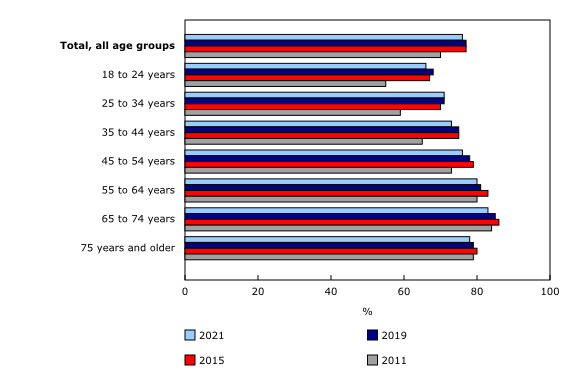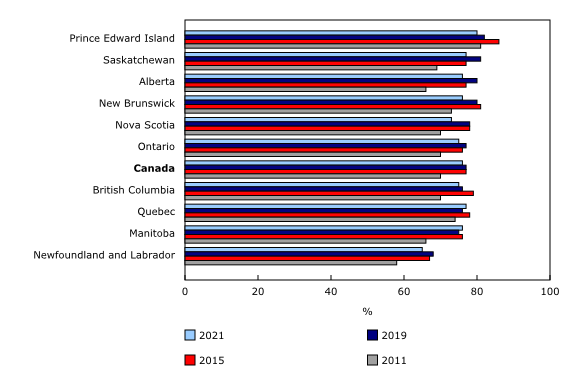Reasons for not voting in the federal election, September 20, 2021
Archived Content
Information identified as archived is provided for reference, research or recordkeeping purposes. It is not subject to the Government of Canada Web Standards and has not been altered or updated since it was archived. Please "contact us" to request a format other than those available.
Released: 2022-02-16
Voter turnout among youth returns to 2015 level
Three-quarters (76%) of eligible Canadians reported voting in the 2021 federal election, down 1 percentage point from the 2019 election.
Among eligible youth aged 18 to 24, 66% cast a ballot in the 2021 federal election, down 2 percentage points compared with 2019. This decline marks a return to the 2015 level, but youth turnout remained well above the rate observed in 2011 (55%).
Declines of 2 percentage points were also observed among 35- to 54-year-olds and people aged 65 to 74. A smaller drop of 1 percentage point was seen among people aged 55 to 64.
Voter turnout rises in Quebec, drops in six other provinces
Quebec was the lone province where voter turnout was higher in 2021 than in the 2019 federal election, rising 1 percentage point to 77%.
Compared with 2019, the proportion of eligible Canadians who reported voting in 2021 fell in Nova Scotia (-5 percentage points to 73%), Alberta (-4 percentage points to 76%), Saskatchewan (-4 percentage points to 77%), New Brunswick (-4 percentage points to 76%), Newfoundland and Labrador (-3 percentage points to 65%), and Ontario (-2 percentage points to 75%).
Voter turnout in 2021 was little changed from 2019 in Prince Edward Island, Manitoba and British Columbia.
Not being interested in politics remains most common reason for not voting
Among eligible Canadians who did not vote in 2021, the most common reason for not casting a ballot was not being interested in politics (32%). Similar to 2019, this was the most commonly cited reason in the majority of age groups, with two exceptions: illness or disability (39%) was the most reported reason among people aged 75 and older, and being too busy (34%) was most prevalent among those aged 35 to 44.
Overall, citing political issues (including not being interested in politics) as a reason for not voting was more common among men (41%) than among women (37%).
COVID-19 was not a common reason for not voting in 2021
Overall, the COVID-19 pandemic accounted for 2% of all reported reasons for not voting in the 2021 election. Among COVID-19-related reasons cited by non-voters, approximately two-thirds were related to being worried about contracting the virus. The remaining one-third was made up of people who were sick with COVID-19 or self-isolating, people who disagreed with holding an election during the pandemic, and people who were dissatisfied with the protocols put in place to allow for safe voting. Not voting because of the pandemic was more commonly cited among older age groups.
Leading up to the election, most jurisdictions were in the final or near-final stages of a reopening plan, and capacity limits in non-essential settings were beginning to be replaced by proof-of-vaccination requirements. However, rising COVID-19 case numbers in September led some regions to reintroduce masking requirements in indoor public spaces or pause some aspects of their reopening plans.
Many eligible Canadians report being too busy as reason for not voting
Not voting because of obligations related to everyday life made up 43% of all reasons reported by non-voters. This included being too busy (24%), having an illness or disability (11%), or being out of town (9%).
Electoral process issues more common among new Canadians and youth
Among Canadians who did not vote in the 2021 federal election, electoral process issues accounted for 7% of reasons for not voting, including not being able to prove identity or address, lacking information about the voting process, or having issues travelling to a polling station.
Electoral process issues were most common among naturalized Canadians who were admitted to Canada within the last 10 years (16%). In contrast, Canadian citizens by birth (7%) and naturalized citizens who were admitted in Canada more than 10 years ago (7%) were equally likely to report such issues.
Across age groups, electoral process issues were most prevalent among youth aged 18 to 24 (12%).
Note to readers
Data for this study were derived from five questions added to the October 2021 Labour Force Survey (LFS), commissioned by Elections Canada, to determine the reasons Canadians did not vote in the September 20, 2021, federal election.
These questions were the following:
1. Are you a Canadian citizen?
2. Did you vote in the recent federal election?
3. Why did you not vote?
4. Did you go to a polling station and try to vote? (If the survey respondent answered "could not prove identity or address" to question 3.)
5. In the past 12 months, did you use Elections Canada's online service to check, update or complete your voter registration?
The question "Why did you not vote?" included 22 categories that were divided into five broad groups for this publication:
Everyday life or health reasons: too busy; out of town; illness or disability
Political reasons: lack of information about campaign issues and parties' positions; did not like candidates/parties/campaign; felt voting would not make a difference; did not know whom to vote for; not interested in politics
Electoral process-related reasons: could not prove identity or address; not on voters list; transportation problem/polling station too far; lack of information about the voting process; lines were too long; issues with the voter information card
Reasons related to COVID-19: being sick with COVID-19/quarantining/isolating; fear of contracting COVID-19; dissatisfied with handling of pandemic/election due to pandemic; dissatisfied with voting rules
All other reasons: forgot to vote; religious or other beliefs; weather conditions; other reasons.
Eligible voters as defined in this study exclude people aged 18 and older who were not Canadian citizens, including permanent residents (landed immigrants) who had not yet obtained Canadian citizenship and non-permanent residents (people from another country who lived in Canada and had a work or study permit, or who were claiming refugee status, as well as family members also living in Canada with them) at the time of the survey.
The October LFS was a survey of approximately 56,000 households. The LFS excludes people living on reserves and other Indigenous settlements, full-time members of the Canadian Armed Forces, the institutionalized population, and households in extremely remote areas with very low population density.
Previous studies and post-election surveys have consistently shown that voter turnout rates reported in those studies are higher than voter turnout rates published by Elections Canada. The estimate for the voter turnout rate in this special LFS study (76%) was approximately 13 percentage points higher than the preliminary figure published by Elections Canada (62.25%) following the September 20, 2021, federal election. In a similar survey conducted following the 2019 federal election, the turnout rate from the survey was 77%, approximately 10 percentage points higher than the preliminary figure of 65.95% published by Elections Canada.
Contact information
For more information, or to enquire about the concepts, methods or data quality of this release, contact us (toll-free 1-800-263-1136; 514-283-8300; infostats@statcan.gc.ca) or Media Relations (statcan.mediahotline-ligneinfomedias.statcan@statcan.gc.ca).
- Date modified:



